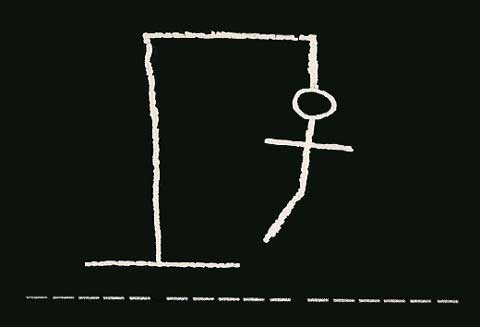Slade's Morgue:
Hangman


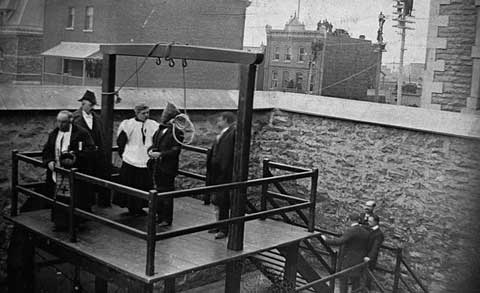
Canada hangs Stanislaus Lacroix in 1902
Note the gawkers in the distance
HANGMAN is Michael Slade's death penalty thriller: hanging and lynching. Here's the story behind it.
On March 29, 1974, John Miller and Vincent Cockriell were drinking at a party. Miller's brother had recently died during a police chase, so they set out to kill a cop for revenge.
In Cloverdale, British Columbia, the courthouse and the police station were side by side. Cockriell hurled a beer bottle through the courthouse window to attract attention. Constable Roger Pierlet was on patrol alone. He stopped their car, radioed in the license number, then approached the driver.

Miller sat in the driver's seat with a cocked rifle resting on his arms. When Pierlet asked Miller to get out of the car, Cockriell pulled the trigger from the passenger's seat and shot him in the heart.
A wild car chase ensued (fictionalized in ZOMBIE, after interviewing the Mounties involved) before the fugitives were rammed at high speed and arrested at gunpoint. Convicted of capital murder, both men were sentenced to hang by the neck until dead. Oakalla Prison's gallows dropped convicts down a disused elevator shaft.
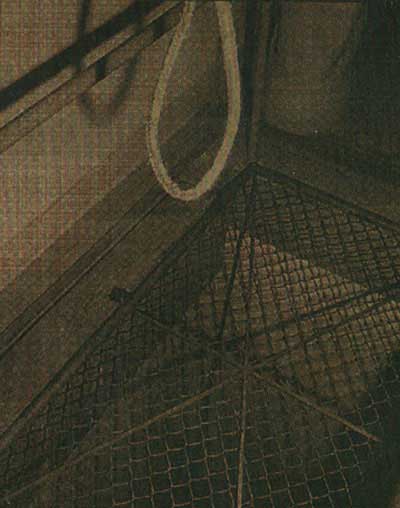
The gallows in Slade's home town
On June 22, 1976, Slade argued Cockriell's appeal against the death penalty before all 9 judges in the Supreme Court of Canada. By tradition, a defense lawyer "sees his client out," so if Slade lost the argument and no one intervened, he'd watch Cockriell hang on Oakalla's gallows.
By 1976, capital punishment had reached the political boiling point. In all, Canadian hangmen had executed 710 convicts: 697 men and 13 women. Fourteen years had passed since the last hanging in 1962, and death penalty advocates pushed for the law to be enforced.
Coincidentally, Slade was set to argue in the Supreme Court at the same time that Parliament held a free vote on capital punishment. On the day before the appeal, a Justice Department official showed Slade a list of the 11 convicts currently on death row. "If hanging's upheld," he said, "we'll have to hang someone."
Cockriell's name topped the list.

The Supreme Court of Canada above the Ottawa River
To argue in the Supreme Court is to know it's the Big Time, and no issue is bigger than whether the state has the right to execute its citizens.
You climb the front steps between the statues of Truth and Justice...

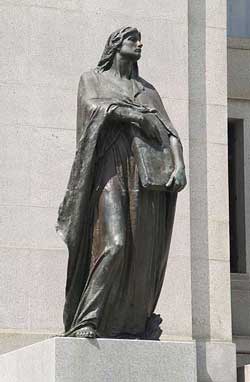

Note the execution sword
...and enter the magnificent Grand Entrance Hall.

Photo by Philippe Landreville
The doors to the Main Courtroom surmount the double staircase. Your footsteps echo off the marble as you climb the right-hand stairs to the Barristers' Robing Room. There, you don the full British regalia, except for the wig.
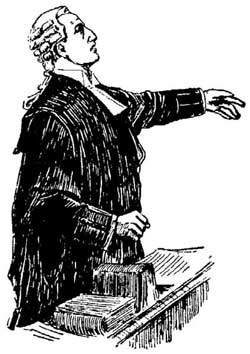
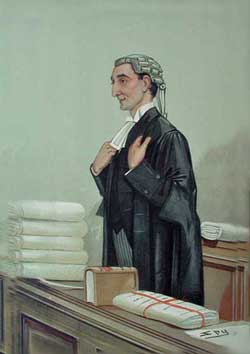
From the Robing Room, you cross to the top of the double staircase and turn right to the Courtroom.
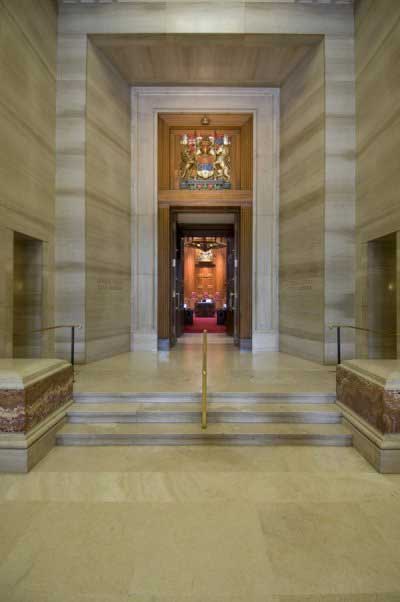
Photo by Philippe Landreville

The Main Courtroom in 1976
Lawyers have a maxim: "Hard cases make bad law." In other words, if you have an important point of law to argue, you don't want the case that raises the issue to have an inflammatory set of facts. In this case, not only had the appellants set out to ambush and kill a Mountie, but he was killed on the eve of his wedding.
Of the dozen times that Slade has argued before the Supreme Court, that hearing was by far the roughest. None of the 9 judges - including the liberals - was in a receptive mood, and right in the middle of the verbal hammering counsel was getting from the bench, a breathless runner arrived from Parliament with 2 slips of paper. The votes to retain hanging were 133. The votes for abolition were 125.
At that moment, in his imagination, Slade saw the trapdoor open and heard his client's neck snap.

The hanging of Roscoe "Red" Jackson in Missouri in 1937
June 22 was a day of high drama on Parliament Hill, and during his dash from the House of Commons to the Supreme Court, the excited runner had mistakenly reversed the slips of paper. The vote to abolish the death penalty was actually 133 in favor, and 125 against.
Hanging was formally outlawed on July 14, 1976. The Supreme Court's unanimous judgment was rendered on October 5.

Canadian edition of HANGMAN
The game begins in Seattle. On Halloween, a woman opens her door to a trick-or-treater in a Munch's Scream mask. Later, she's found hanged with one leg missing.
Then, in Vancouver, a noosed body is found with both legs missing.
What binds these crimes together is a game of "Hangman" crudely drawn at both locations in the victims' blood.
Years ago, the pair were jurors in a trial that sent the defendant to the gallows.
Now, on both sides of the border, Inspector Zinc Chandler and Detective Maddy Thorne are hunting a vendetta killer bent on revenge.
To stop him, they must solve the riddle of the Hangman before a final lynching means the madman wins the game.
The Supreme Court appeal was the catalyst that sparked in Slade the desire to one day write a death penalty thriller. But that was going to be difficult with the death penalty gone.
As with all Slade novels, the inspiration for HANGMAN dates back to his boyhood. It began with a supernatural story of a hanged man's revenge against the jurors who convicted him in an EC Comic, one of the "seducers of the innocent" quashed by the U.S. Congress in 1954 (see GHOUL).
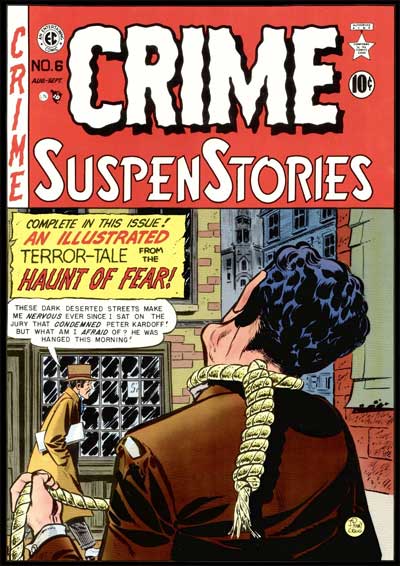
To be a boy in 1950s was to be surrounded by hanging and lynching. The last public execution in the United States took place a mere 11 years before Slade was born. Rainey Bathea was hanged in Kentucky before a huge crowd on a mid-August morning in 1936.

Between 1882 and 1968, 3,446 blacks and 1,297 whites were lynched in the U.S. "Lynching" comes from Charles Lynch, a Virginia justice of the peace during the American Revolution, who imposed the extralegal punishment on Loyalists supporting King George III and his Redcoats.
This photo captures the lynchings of Thomas Shipp and Abram Smith in Indiana in 1930. Copies sold by the 1,000s for 50 cents apiece. Slade saw it and other lynching photos as a boy.
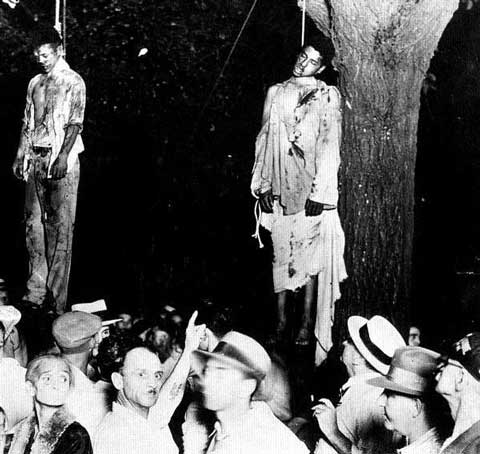
Westerns were rampant in the 1950s, and hanging and lynching were plot staples. THE OX-BOW INCIDENT is a classic of American literature. It was filmed with Henry Fonda in 1943, and young Slade saw it on the new medium of TV.
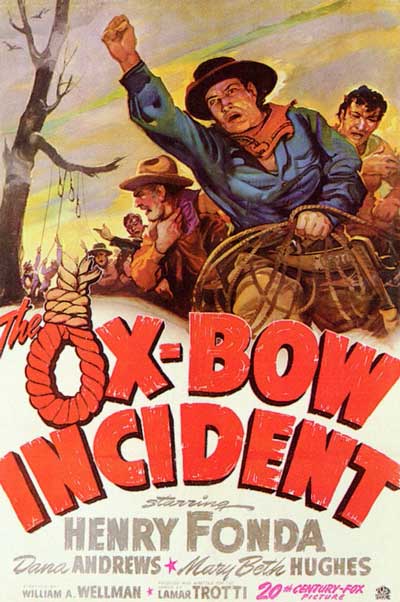
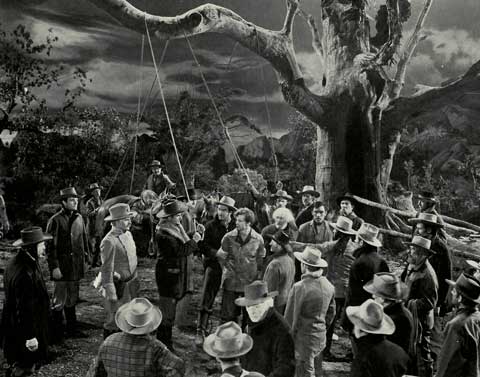
THE OX-BOW INCIDENT
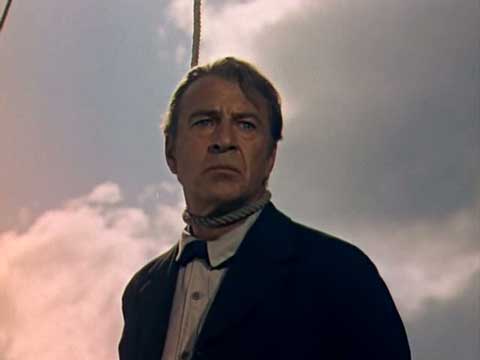
Gary Cooper in THE HANGING TREE (1959)

THE HANGMAN (1959)
In 1958, British Columbia - Slade's home province - celebrated its Centennial. With patriotic fervor, Slade's Grade 6 class constructed a mural about the colony's pioneers. By luck, the section assigned to him was Sir Matthew Baillie Begbie, "the Hanging Judge."
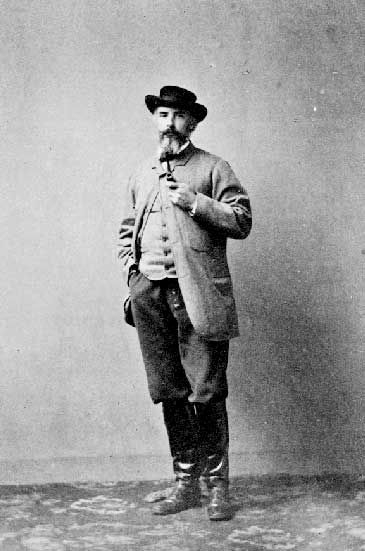
Begbie...

...the Hanging Judge
"Gold!" was the cry that echoed down the Fraser River Canyon in 1857 to summon 30,000 miners north from California's almost-panned-out digs. With them came gamblers, claim-jumpers, and Wild West gunmen tamed by no law but the lynching rope. London feared the miners would petition Washington to annex British Columbia as it had Oregon in 1848. So, to stake Britain's territorial claim, the colonial secretary dispatched an iron-willed judge "who could, if necessary, truss a murderer up and hang him from the nearest tree."
Three days after Begbie docked in November 1858 with a royal proclamation to establish the Mainland Colony of British Columbia in his bag, he swore in the 1st governor at Fort Langley beside the Fraser River. Then, the governor swore in Begbie as B.C.'s 1st and only judge.
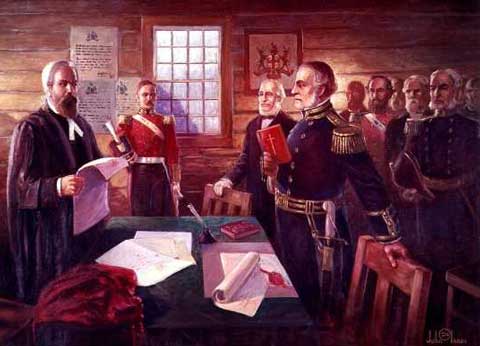
Begbie creates the Colony of British Columbia, by John Innes
Three months later, Begbie walked 350 miles round-trip up the Fraser River Canyon through Hell's Gate to the gold digs at Lillooet to familiarize himself with the lawless mining camps. Along the way, he let it be known, "Boys, if there's any shooting here, there will be a hanging here."
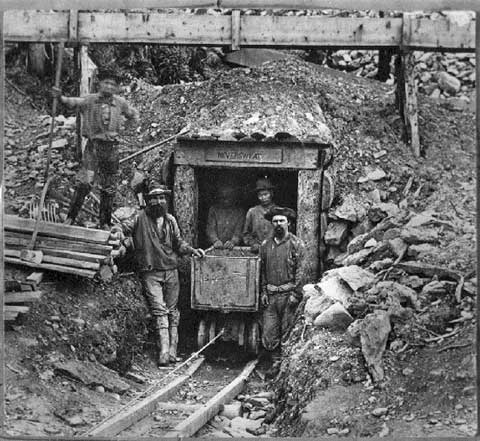
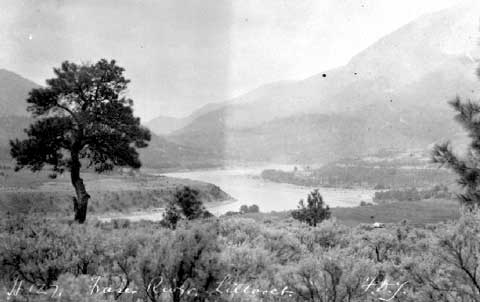
Lillooet, as Begbie saw it
Note the gnarled ponderosa pine on the left
Legend says up to 12 men died on Lillooet's Hanging (or Hangman's) Tree. Begbie strung up at least 2 during the Fraser Canyon War in the winter of 1858-59. For B.C.'s Centennial, Lillooet built a park around its frontier gallows. Later, every time he did a trial in Lillooet, Slade would visit the Hanging Tree. It was cut down in 2003, but the pieces are still there.

Lillooet's Hanging Tree
By 1865, Begbie was riding 3,500 miles a year on his trial circuit. At just under 6-foot-5-inches in height, he was an imposing hangman with a waxed mustache, a Van Dyke beard, and a withering glare. Dressed in the wig and black robes of a British judge, he held court on horseback, or standing on a stump, or in the nearest log cabin.
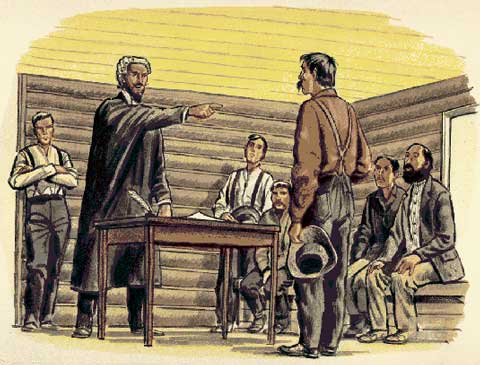
Begbie holds court
North of the U.S. border and west of the Rocky Mountains, Matthew Baillie Begbie was the law. Almost single-handedly, he tamed the Fraser Canyon and Cariboo Gold Rushes (1856-1866). News that Begbie was coming could clear out a mining camp.
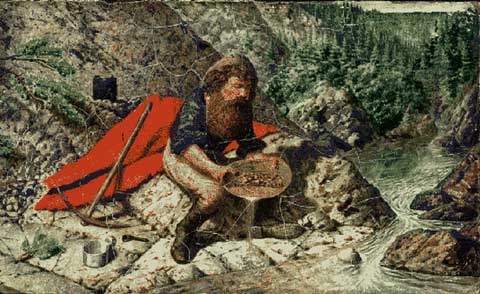
Begbie-isms are many. The Cariboo Trail ran north from Lillooet to Barkerville, where a newspaper dubbed Begbie the "Haranguing Judge." In sentencing, he would quote Greek and Latin poets, then tack on strokes of the whip. "If a man insists on behaving like a brute, after fair warning, and won't quit the Colony, treat him like a brute and flog him."
An American the judge sentenced to death said he wished to appeal. "It will take 6 months or more for the colonial secretary to deal with the matter, and months more before we learn of his decision. But you will not be interested in what he decides, for you are to be hanged Monday morning."
One night, while smoking on the balcony of a miners' hotel, Begbie overheard ruffians below plotting to shoot him as he rode out of town. Returning to his room, he grabbed the chamber pot and emptied its urinary contents over the heads of the conspirators.
"The jurymen say you are not guilty," he told a lucky accused, "but with that I do not agree. It is now my duty to set you free, and I warn you not to pursue your evils ways. But if you ever again should be so inclined, I hope you select your victim from the men who have acquitted you."

Barkerville in the 1860s
An American gunslinger named Gilchrist took a shot at an Irishman during a poker game and killed a bystander. The jury's verdict was manslaughter. "Your crime was unmitigated murder. You deserve to be hanged. Had the jury performed their duty, I might now have the painful satisfaction of condemning you to death. And you, gentlemen of the jury, are a pack of Dallas horse thieves. Permit me to say, it would give me great pleasure to see you hanged, each and every one of you, for declaring a murderer guilty only of manslaughter."
On a vacation in Salt Lake City, Begbie ran into an American former jurist. The American said, "You certainly did some hanging, judge." Begbie replied, "Excuse me, my good man. I never hanged any man. I simply swore in good American citizens like yourself, as jurymen, and it was you who hanged your fellow citizens."
On finishing court in Barkerville, Begbie asked for his hotel bill, and overheard the proprietor tell the desk clerk to "Sock it to him." The next assize saw the proprietor serve as foreman of the jury. "If, gentlemen, you have a reasonable doubt as to the prisoner's guilt, give him the benefit of it. But if the circumstances you have heard related permit of only one solution - that the prisoner is the guilty man - then, Sock it to him, Sock it to him." The foreman got the message, and held out until the other jurors agreed to a guilty verdict.

A Cariboo Gold Rush pack team
To shorten the distance to Barkerville required a new road through Tsilhqot'in (Chilcotin) Indian land. The Gold Rush incursion was stopped by the Chilcotin War of 1864, when 19 whites, including a pack team, were killed by Native warriors led by Chief Klatsassin.
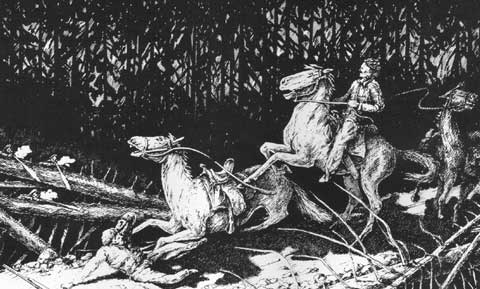
The Chilcotin War
Begbie tried 5 Tsilhqot'in leaders for murder and had them hanged. Two hundred people came to watch Klatsassin and the other chiefs die.
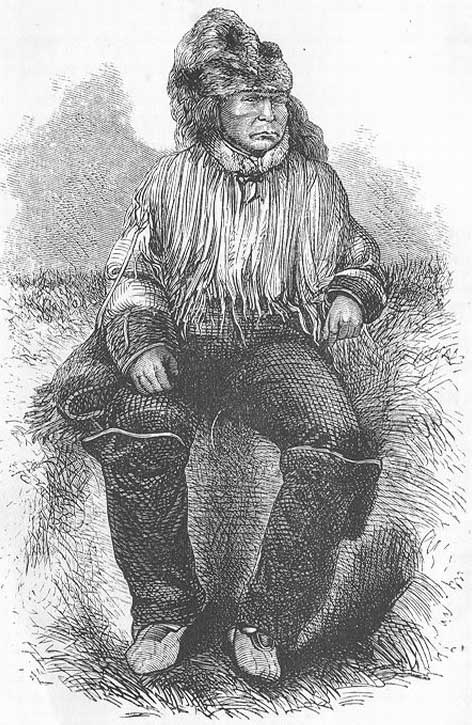
Klatsassin (probably)
In 1871, British Columbia joined Canada. Begbie was B.C.'s chief justice from 1858 until his death in 1894. Today, his statue stands out front of New Westminster's new Law Courts...

Compare with the 1st Begbie photo above
...staring across Begbie Square at the old Begbie Courthouse, in which Cockriell and Miller were tried and sentenced to hang for the capital murder of Constable Pierlet in 1974.
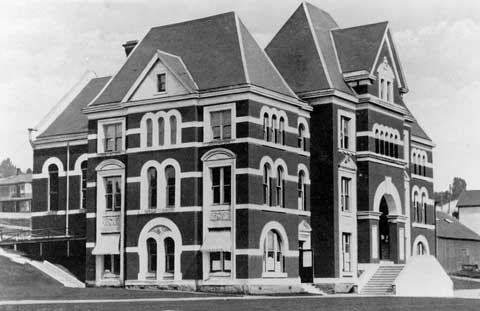
Begbie's Courthouse
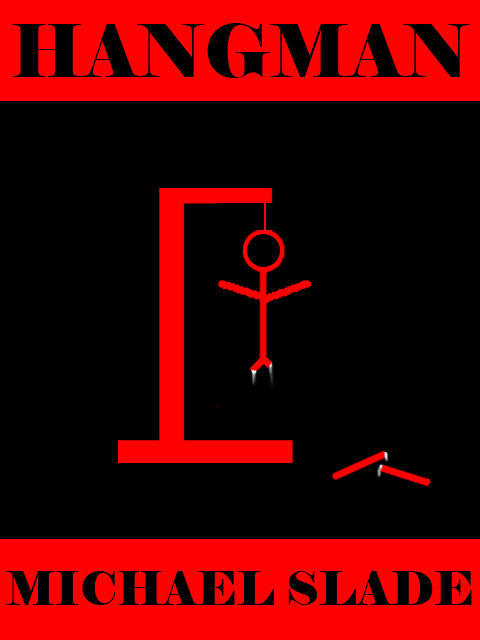
Michael Slade challenges you to a game of HANGMAN.
A woman is found hanging in her Seattle home with one leg cut off to match a Hangman game scrawled in blood on the wall. A week later, another woman is hanged in her Vancouver townhouse with both legs cut off. This time, the no-leg Hangman game has a filled-in letter.
When the grisly attacks are linked as the work of a cross-border killer, RCMP Inspector Zinc Chandler and Seattle Homicide Detective Madeline Thorne form an uneasy alliance to hunt the elusive Hangman.
The murders attract other players who want in on the game: small-time lawyer Jeffrey Kline, out to make his name off the sensational killings; his hapless legal partner, Ethan Shaw; veteran crime reporter Justin Whitfield and media shark Sue Frye, who fight for the story; and Zinc's girlfriend, crime writer Alexis Hunt.
No one is quite who they seem, and when the secrets of the past explode in a stunning courtroom climax, the perverse verdict leads to a final hangman's noose.
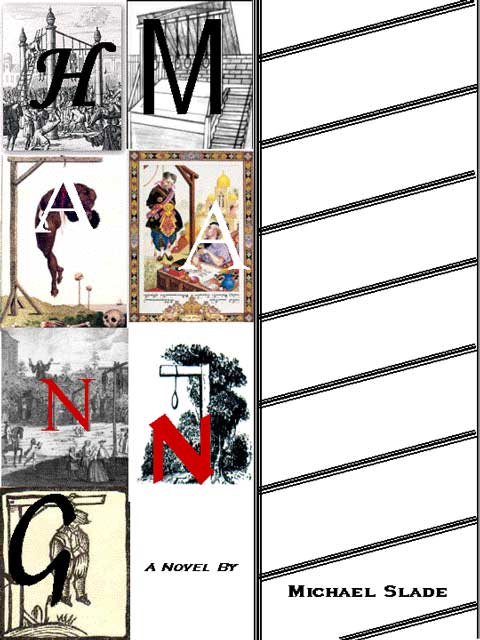
"A harrowing tale of revenge. HANGMAN is a hardboiled police procedural based on the tough realities that Slade faced every day in court. The hallmark of a Slade novel is extensive research. Readers come away not only entertained - and terrified - but also enlightened." - Cemetery Dance
"HANGMAN's escalating suspense is sustained not only by readers wondering 'whodunit,' but who will be the next to die. Every character is both a suspect and a potential victim. HANGMAN is an inventive, occasionally hilarious horror-mystery that delivers the goods by the bloody bag-full." - Quill & Quire
"Murder with gore galore, and a killer who enjoys his hobby. There's plenty of legerdemain before the trick ending." - The Globe and Mail
"Fascinating stuff. The research on real-life hangmen is deftly larded into the fast-paced story." - The Vancouver Sun
"Master of the Northern Giallo! There are more than a few reasons to take the stand and scream the glories of literary demon Michael Slade." - Rue Morgue
"I love the Michael Slade books. A perfect combination of mystery and horror. And I love the history angles he throws in. My favorite so far has been RIPPER, or maybe HANGMAN. But I love them all." - Jon Jordan, Crime Spree Magazine
"First-hand knowledge of the judicial system gives Slade's thrillers their authenticity." - North Shore News
"Slade's got credibility. He's like Patricia Cornwell or Kathy Reichs. All three know what they're talking about. The difference is that I think his books are better written."
- Robert Blackwood, Vancouver International Writers Festival
In plotting HANGMAN, Slade lucked out with the evolution of the death penalty in the United States. Until the 1890s, hanging was the primary method of execution south of the Canadian border. Four conspirators in the assassination of President Lincoln were hanged in 1865.
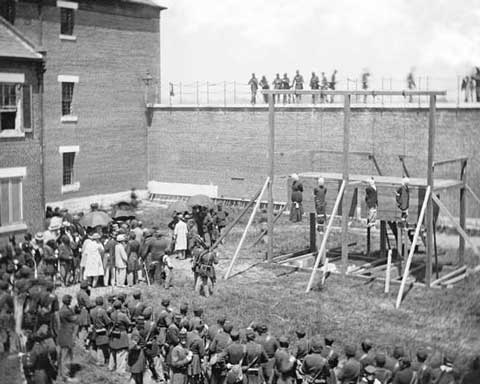
Like Butch Cassidy's Wild Bunch, Texas desperado and train robber "Black Jack" Ketchum joined the Hole-in-the-Wall Gang. In 1901, gawkers came from miles around to watch Black Jack hang in New Mexico. On mounting the gallows, he told the hangmen, "I'll be in hell before you start breakfast, boys."
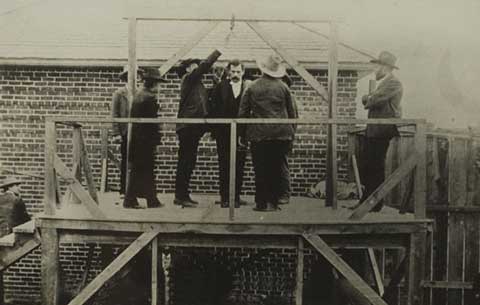
"Let her rip!" were Black Jack's last words. Prophetically, the hangmen miscalculated the drop. So indeed, the over-long rope ripped off Ketchum's head.
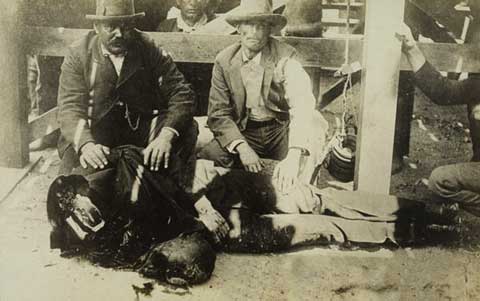
In 1881, New Mexico also gave us this gallows humor death sentence by a federal judge sitting at Taos in an adobe stable used as a makeshift courtroom:
"Jose Manuel Miguel Xavier Gonzales, in a few short weeks it will be spring. The snows of winter will flee away, the ice will vanish, and the air will become soft and balmy. In short, Jose Manuel Miguel Xavier Gonzales, the annual miracle of the years will awaken and come to pass, but you won't be there.
"The rivulet will run its soaring course to the sea, the timid desert flowers will put forth their tender shoots, the glorious valleys of this imperial domain will blossom as the rose. Still, you won't be here to see.
"From every tree top some wild woods songster will carol his mating song, butterflies will sport in the sunshine, the busy bee will hum happy as it pursues its accustomed vocation, the gentle breeze will tease the tassels of the wild grasses, and all nature, Jose Manuel Miguel Xavier Gonzales, will be glad, but you. You won't be here to enjoy it because I command the sheriff or some other officers of the county to lead you out to some remote spot, swing you by the neck from a knotting bough of some sturdy oak, and let you hang until you are dead.
"And then, Jose Manuel Miguel Xavier Gonzales, I further command that such officer or officers retire quickly from your dangling corpse, that vultures may descend from the heavens upon your filthy body until nothing shall remain but bare, bleached bones of a cold-blooded, copper-colored, blood-thirsty, throat-cutting, chili-eating, sheep-herding, murdering son-of-a-bitch."

In 1959, 4 members of the Clutter family...
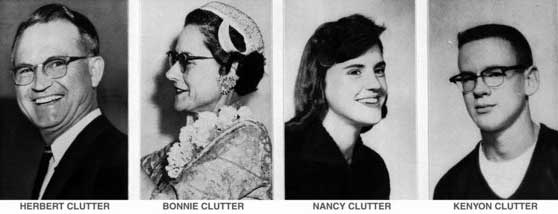
...were murdered in their rural Kansas home...

...by Perry Smith and Dick Hickock, two ex-cons who thought - erroneously - there was money in a safe. They slit Herb Clutter's throat, then shot all 4 bound victims.
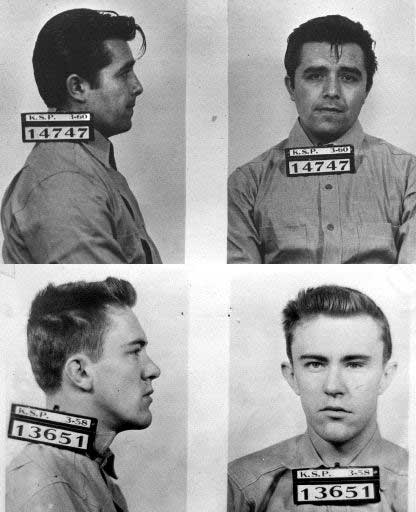
Smith (top) and Hickock
In 1965, both men were hanged on the gallows - nicknamed "The Corner" - at the Kansas State Penitentiary.
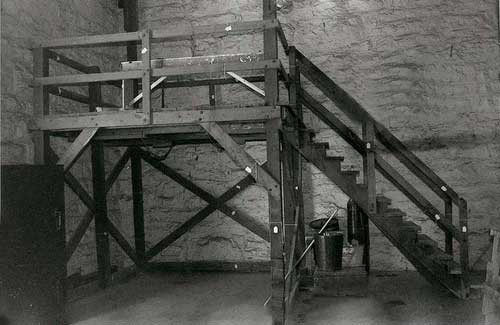
The following year, Truman Capote published IN COLD BLOOD, his "non-fiction novel" about the Clutter murders. Released in 1967, the stark black-and-white film by Richard Brooks ends with the realistic and horrifying hanging of Smith. Having "won" a coin toss, Hickock dies first. Then, harnessed, shackled, hooded, and noosed...

...Smith plunges through the trapdoor, snaps his neck, and jerks at the end of the hangman's rope.
That was the image that flashed through Slade's mind when the runner from Parliament mixed up the votes in the middle of Cockriell's and Miller's Supreme Court appeal.
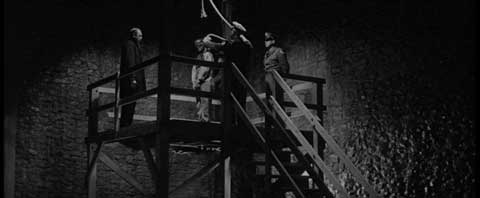
IN COLD BLOOD (1967)
Between 1926 and the last 4 hangings in Kansas (including Smith and Hickock) in 1965, 30 states sent 675 convicts to the gallows. By the close of the 20th century, only 3 states - Washington, New Hampshire, and Delaware - retained hanging. And only Washington still lets those on death row choose the noose.
How fortunate for HANGMAN's plot that Washington State borders British Columbia.
Twenty-eight years had passed since America's last hanging when triple-child-killer Westley Allan Dodd plunged through the trapdoor at the Washington State Penitentiary in 1993.
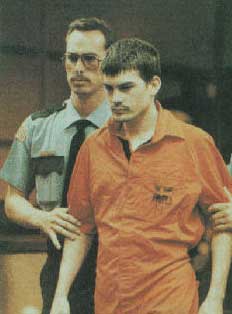
Dodd
Washington's death house has two levels for hanging on the top floor and lethal injection in the trapdoor pit below.

Note the rope hook on the ceiling in the upper chamber
To "toe the line" has special meaning when it comes to hanging. The executioner chalked a line on the trapdoor of British gallows to show the condemned convict where to stand. Those who went to their death without a struggle were said to "toe the line."
Charles Rodman Campbell had no intention of toeing the line in 1994 when his time to hang on Washington's gallows came for the throat-slashing revenge murders of 2 women and a child. First, he declined his last meal and wouldn't get up off the floor of his cell without being pepper-sprayed. Then he refused to walk to the gallows and stand on the trapdoor, so he was strapped to an upright board and positioned by prison guards. Finally, he tried to rotate his head to escape the hangman's noose...but all to no avail.
In this photo of Washington's gallows, note the strapped board propped against the wall.

Between 1904 and Campbell's 1994 death on the gallows, 75 convicts "danced with the hangman" in Washington State.
Here's how HANGMAN opens:


The Anglo-American jury system is fraught with high drama. A capital murder trial plucks 12 ordinary citizens from their everyday lives and charges them - in Washington State - with making a life-or-death decision that can send an accused to the gallows.
Slade saw 12 ANGRY MEN (1957) in his pre-teens. In that classic film, the situation is the reverse of the Begbie "Sock it to him" story above. Instead of the hotel proprietor holding out for conviction, Henry Fonda is the only juror who votes against a quick guilty verdict.

A lot can go wrong in the jury room. Racism, sexism, religious hatred, xenophobia, national security fears, personal bias, and bullying may influence verdicts. Threats and bribes can taint jurors. Unfair judges can sway them with jury charges that lack balance. In practicing law, Slade saw jurors faint and burst into tears. In one of his attempted murder trials, a Crown witness failed to show up for court. When he appeared the next day, he had a wound in his leg. It was alleged that a hit man had shot him on his way to court. Or did he injure himself to sway the jury? Doctors couldn't decide.
In a sensational B.C. case, a female juror got romantically involved with a man she was trying for murder. After his acquittal, she was charged with obstruction of justice. Other jurors testified at her trial that she had harrassed them into acquitting the alleged killer. On conviction, the juror was sentenced to 18 months in prison.
Perhaps the worst case of wrongful conviction took place at London's Old Bailey courthouse in 1950.
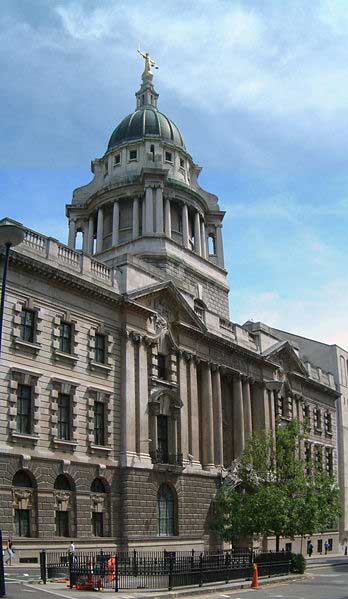
The Old Bailey

Justice with her sword and scales atop the Old Bailey
No country has a more storied history of hanging than Britain. The best anecdotes are threaded through HANGMAN. Unlike America, Britain didn't hide its hangmen away. Each achieved a level of personal notoriety. So here's a whodunit. Who killed British hanging?
The hangman who served the longest - 1829 to 1874 - was William Calcraft. Death by slow strangulation from the "short drop" was his trademark. If Calcraft pitied a client, he'd pull down on one leg to hurry death along. Thus the expression "You're pulling my leg." If relatives performed the task, they were "hangers-on."
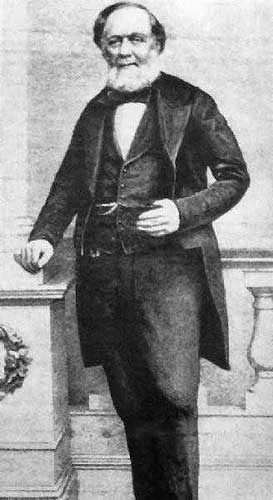
Calcraft
Calcraft made extra money by selling the clothes of those he hanged to Madame Tussaud's waxworks to outfit their effigies. And relic hunters paid him up to 5 shillings an inch for pieces of the ropes that strangled well-known convicts.
In 1868, Calcraft performed the last public hanging out front of Newgate Prison. After that jail was demolished, the current Old Bailey was built on the site in 1902.

Victorian children enjoyed a riddle:
"If Pa killed Ma
"Who'd kill Pa?"
The answer? "Mar-wood"
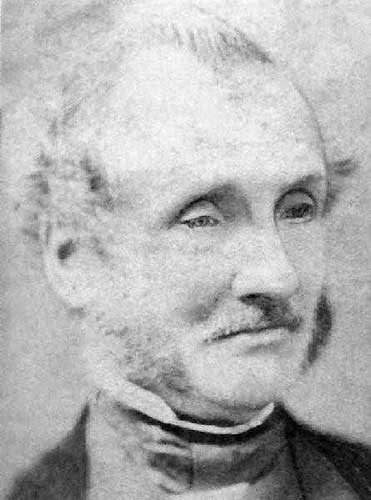
Marwood
William Marwood, a cobbler, performed his 1st hanging in 1872, and served as Britain's public executioner until 1883. In all, he hanged 176 people, including the infamous Charles Peace, who's mentioned in a Sherlock Holmes story: "The Case of the Illustrious Client."
If ever there was a hangman suited to the job, it was Marwood. "Calcraft hanged them. I execute them," he boasted. Marwood made hanging a science by developing the "long drop." Instead of slow strangulation, he snapped his clients' necks. "I am doing God's work according to the Divine command and the law of the British Crown. I do it simply as a matter of duty and as a Christian." So pious was Marwood that he would kneel down and pray for the soul of the convict he was about to hang. His business card read:
WILLIAM MARWOOD
Public Executioner
Horncastle, Lincolnshire
Once, he tripped while climbing the steps to the gallows. "Someone will be killed coming up these steps, if they don't mind," he quipped.
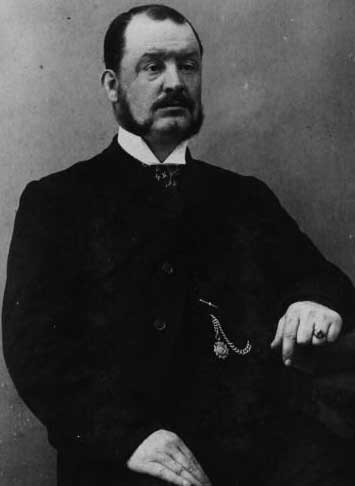
Berry
Ex-policeman James Berry took up hanging after he was injured in a pub fight. Though he executed 134 convicts between 1884 and 1892, he is best known for "The Man They Couldn't Hang," John Babbacombe Lee.
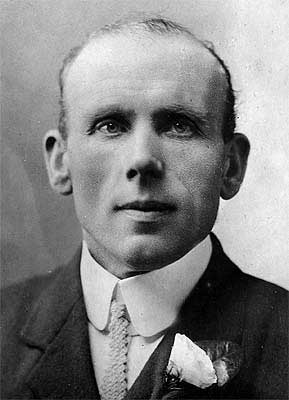
Lee
Lee was a footman for a wealthy matron. When she reduced his wages, he beat her, cut her throat, and tried to burn her body. Three times, Berry placed him on the drop at Exeter Prison in 1885, and 3 times, the trapdoor wouldn't spring. Yet when it was tested after each failed hanging, it worked every time.
Spooked officials postponed the hanging, and Lee's sentence was commuted to life imprisonment because of that ordeal. Berry thought it was the hand of God intervening to stop him from killing an innocent man. After a nervous breakdown, he became an evangelist preaching the gospel.

Ellis
If ever there was a hangman ill-suited to the job, it was John Ellis. A barber by trade, he took the position on a dare. Among the 203 convicts Ellis "put away" between 1901 and 1924 (he disliked the terms "hang" and "execute") were some of the most reviled murderers of the day. Crippen in 1910. Seddon in 1912...
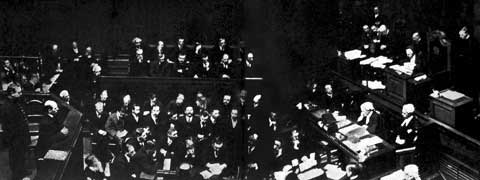
Poisoner Frederick Seddon being sentenced to hang
...Smith - the "Brides in the Bath" killer - in 1915. And Major Herbert Armstrong in 1922. Armstrong poisoned his wife with arsenic weed killer. As Ellis pulled the lever on the gallows at Gloucester Prison, legend says the major cried, "I'm coming, Katie," the name of his murdered wife.
This photo of the "Cold Meat Shed" at London's Wandsworth Prison shows the gallows lever pulled by Marwood, Berry, and Ellis.

Hanging Edith Thompson unnerved Ellis. Edith was married to boring Percy Thompson when she fell in love with younger, adventurous Freddy Bywaters.
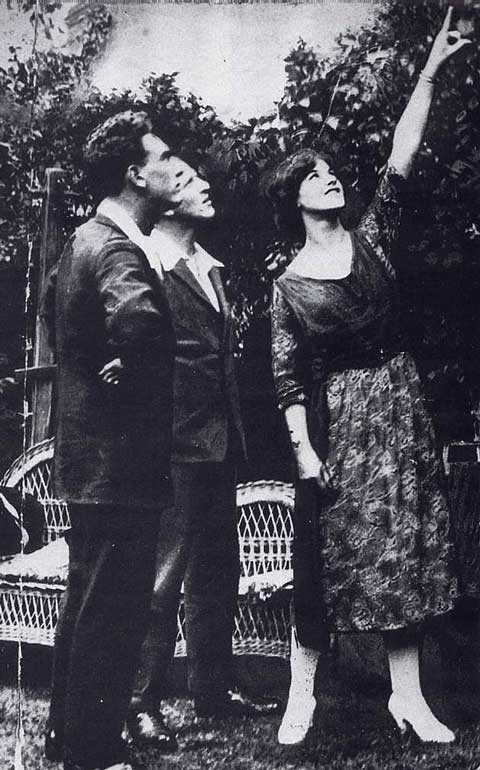
Freddy, Percy, and Edith (1921)
As Edith and Percy came home from the theater, Freddy jumped out of the bushes and stabbed Percy to death. Damned by her love letters, Edith and Freddy were jointly tried for murder. On being sentenced to hang, Edith screamed hysterically in court.
The case became a cause celebre. Almost a million people petitioned to save Edith. For days before her hanging in 1923, Edith cried, wailed, and refused to eat. Unable to stand, she was carried to the gallows and held up by 4 warders while Ellis cinched the noose. The jerk of the rope caused internal hemorrhage and she bled all over the place. Women hanged after that wore canvas underwear.
Severely rattled, Ellis retired and took to drink. In 1924, he attempted suicide by shooting himself in the jaw. For a while, he toured with a hanging exhibition.

Finally, in 1932, after threatening his wife and daughter with a razor, Ellis put himself away by cutting his own throat.
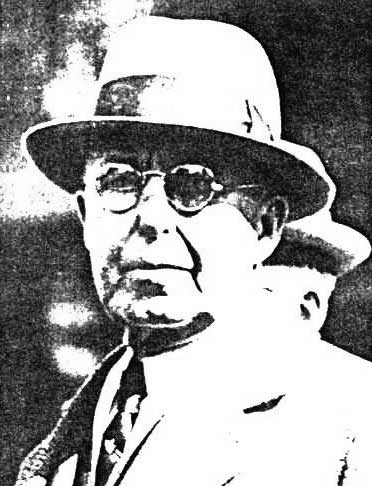
"Arthur Ellis" (Arthur B. English)
British hangman John Ellis and Arthur B. English were cousins. English found work as a hangman in the Middle East and South Africa before becoming Canada's official executioner in 1913. He took the pseudonym "Arthur Ellis" to connect him to his famous cousin. Before "Ellis" died in 1938, he conducted 549 hangings.
Up to the last execution in 1962, all Canadian hangmen adopted the name "Ellis." Had the noose not been abolished in 1976, Slade would have seen "Ellis" hang Cockriell on Oakalla's gallows.
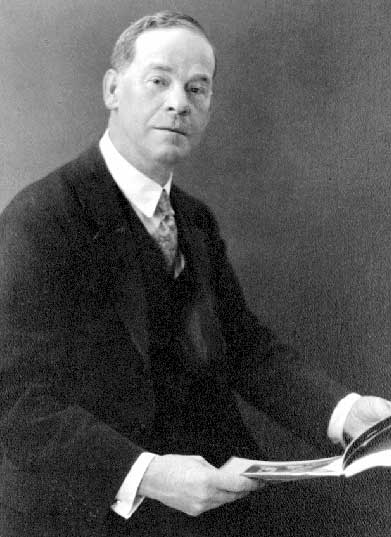
Francis Rattenbury (1924)
In 1892, Francis Rattenbury arrived in British Columbia to make his name as an architect. He won the competition to build the new Legislature in Victoria, the capital, which opened in 1898.

Victoria's Legislature
Rising fast to become B.C.'s dominant institutional architect, Rattenbury designed the Empress Hotel, which opened in 1908...

Victoria's Empress Hotel
...and the Vancouver Courthouse, which opened in 1911.


The Rattenbury Courthouse (1933)
In his 1st decade as a criminal lawyer, Slade defended and prosecuted murder cases in the Rattenbury Courthouse, and argued all his appeals in its east wing. That's where the Cockriell and Miller appeal from the Begbie Courthouse was dismissed, which sent the case east to the Supreme Court of Canada.
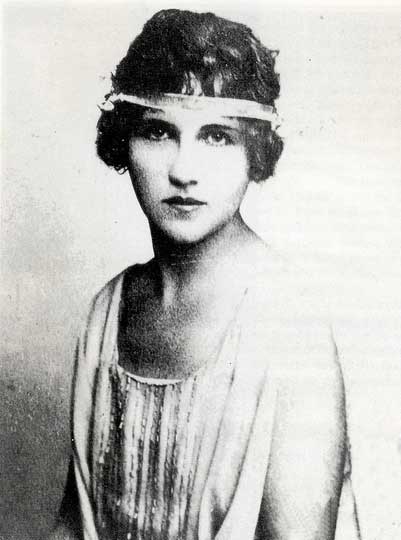
Alma Pakenham
In 1923, Rattenbury abandoned his staid wife for vivacious "flapper" Alma Pakenham, 30 years his junior. Alma's pet name for him was "Rats." Shunned by Victoria's polite society, the outcasts moved to England and set up house in Bournemouth in 1928.
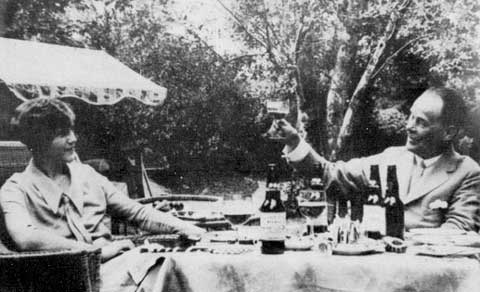
Within 6 years, Alma was bored, so she placed an ad in the newspaper for a chauffeur-handyman. Dim-witted, 18-year-old George Stoner applied and soon became Alma's lover.
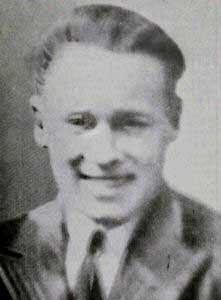
Stoner
One night, in a fit of jealousy, Stoner smashed Rats on the head with a mallet in the Rattenbury home. When Alma got drunk and falsely confessed to save Stoner, then Stoner confessed to save Alma, the lovers were jointly tried for murder at the Old Bailey in 1935.
In early 20th century Britain, nothing made for a cause celebre like an older woman and a younger man doing in a cuckolded husband. Rattenbury was 67; his wife was 38; and Stoner was 18.
The jury acquitted Alma. Stoner was sentenced to hang. Three days after her release, Alma went to the Three Arches over the River Avon and stabbed herself 6 times.

Three Arches
A million signatures couldn't save Edith Thompson from being hanged by John Ellis, but 300,000 saved George Stoner from meeting one of the Pierrepoints on the gallows. After Alma's suicide, his sentence was commuted to life imprisonment, and he was released 7 years later.
In 1977, Slade saw Glynis Johns as Alma Rattenbury in CAUSE CELEBRE, Terence Rattigan's play about the case, at Her Majesty's Theatre in London. At one of the performances, George Stoner - then 61 - was spotted in the audience.
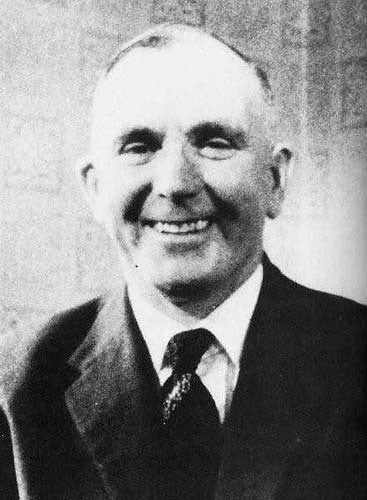
Albert Pierrepoint
The Pierrepoints made hanging a family affair. From 1901 to 1956, they pulled the lever on more than 800 convicts.
Henry (known as Harry) hanged 107, until he was sacked in 1910 for showing up drunk and having a fight with his assistant, John Ellis.
Tom was Henry's brother. He hanged over 300 up to 1946, including more than a dozen U.S. servicemen.
Albert was Henry's son. Tom was Al's uncle. A family pun dubbed the gallows shed "Uncle Tom's Cabin." When visiting Uncle Tom's farm as a boy, Al would taunt the billy goat and watch it charge...until the tether yanked it to a halt. One of his class essays began: "When I leave school I should like to be the Official Executioner." That wish came true in 1943, when Tom retired as Britain's "Number One" hangman.
After the war, Al hanged 200+ Nazis, including the Beast and Bitch of Belsen: Josef Kramer...
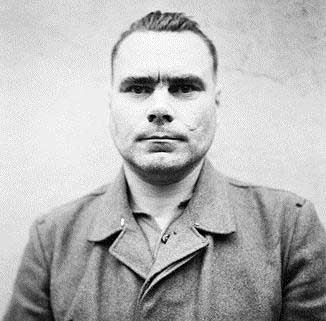
...and Irma Grese.
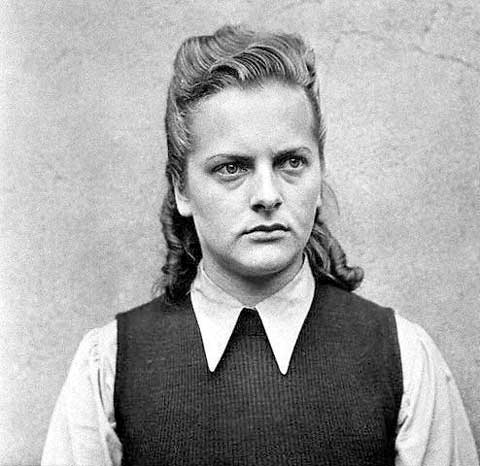
On his backpacking trek around Europe in 1967, Slade toured Scotland Yard's Black Museum of macabre relics from Britain's most heinous crimes (see RIPPER). There, he saw the riding crop used by sadist Neville Heath, and the gallstones that doomed the Vampire Killer, John Haigh, after he dissolved a body in a drum of sulphuric acid.
Heath, Haigh, Lord Haw-Haw, and Ruth Ellis: all were dispatched by Al Pierrepont in his estimated 435 hangings.

PIERREPOINT (2005)
In the Black Museum, Slade saw the ropes used to hang various killers...

...and the pubic hair fetishes kept in a tobacco tin by the monster who killed British hanging.
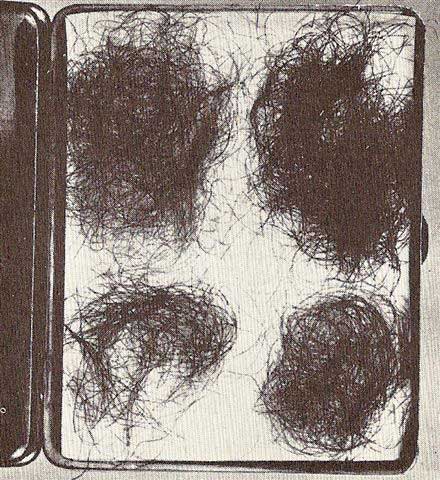
There's no more infamous address in London than 10 Rillington Place. On his 1st trip to Britain as a teen in the early 1960s, young Slade - inspired by the image below - went looking to find its backyard. Because the site was renamed Ruston Close, his search was unsuccessful.
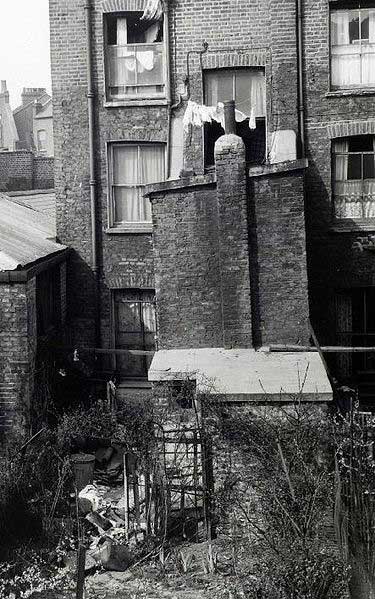
In 1949, Timothy Evans - a mentally defective laborer - walked into a Welsh police station and made conflicting statements about the deaths of his wife and 14-month-old daughter in his top-floor flat at 10 Rillington Place. Scotland Yard found their strangled bodies in the backyard shed.
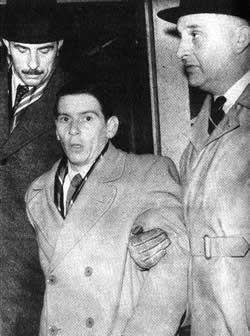
Evans
Evans stood trial for murder. John Reginald Halliday Christie, who lived in the apartment below, was the Crown's star witness.
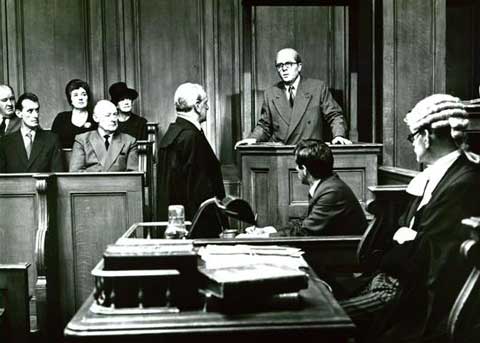
10 RILLINGTON PLACE (1971)
Evans' defense was "Christie did it." The jury disagreed. So, on March 9, 1950, Albert Pierrepoint hanged Timothy Evans.
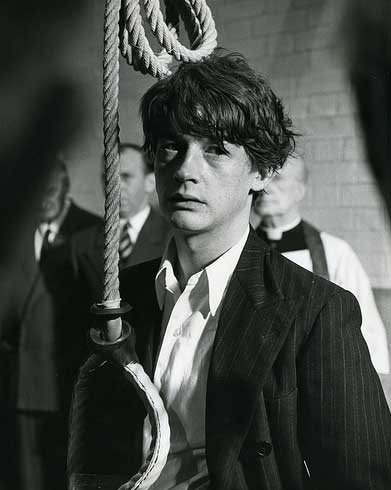
John Hurt as Evans
Three years later, Christie vacated his flat. The tennant upstairs came down to clean up and found three naked women dead in a papered-over cupboard. He called the police, and their digging uncovered two more women buried in the yard and Mrs. Christie's body under the floorboards.


Richard Attenborough as Christie

Christie
Christie, it turned out, was a necrophiliac. "Can't Do It Christie" and "Reggie-No-Dick" were his names at school. From 1943 to 1953, he had lured women home to gas and strangle so he could rape their corpses. He kept their pubic hair in a tin for masturbation later. In one of his statements, he also confessed to killing Mrs. Evans.

On July 15, 1953, Albert Pierrepoint hanged John Reginald Halliday Christie. What he couldn't do was "unhang" Evans. The case led to an inquiry, which helped spur legislation, and Britain abolished hanging in 1964. Two years later, Timothy Evans was posthumously pardoned.
In 1967, Slade hitchhiked to Oslo, Norway. His must-see in the National Gallery was the 2nd-most famous painting in the world. And like so many before him, he stared at it, mesmerized, and lost track of time.
When he saw 10 RILLINGTON PLACE in 1971, the unjust hanging of Evans brought that painting to mind. Having lost his wife, having lost his daughter, and having been wrongfully convicted by Christie, what did Evans experience as Pierrepoint cinched the noose around his neck?
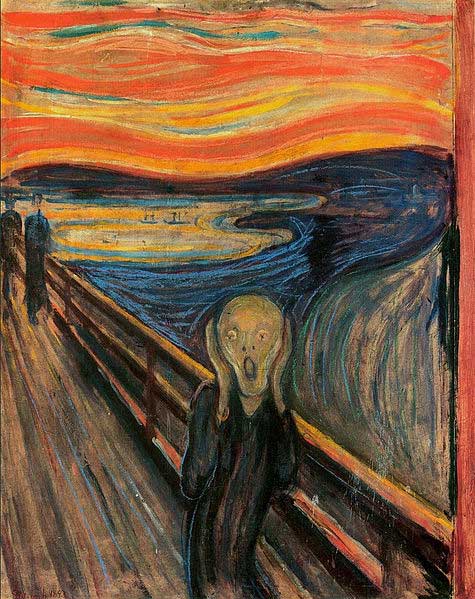
THE SCREAM by Edvard Munch (1893)
From all of that inspiration came HANGMAN, published in 2000.
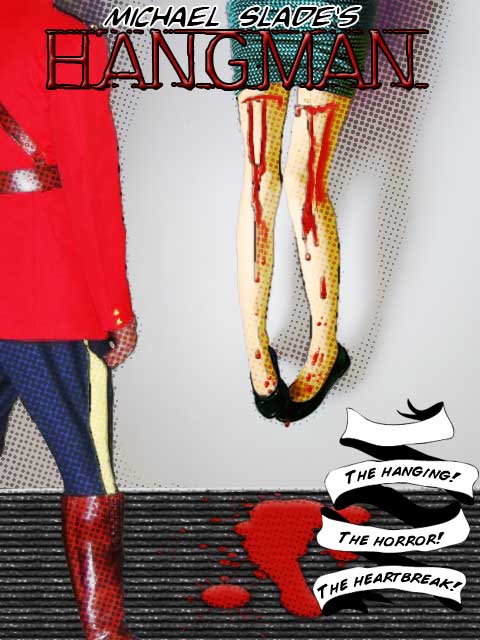
"A thin line separates crime and horror, and in Michael Slade's thrillers the demarcation vanishes altogether." - Time Out
